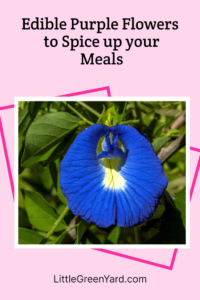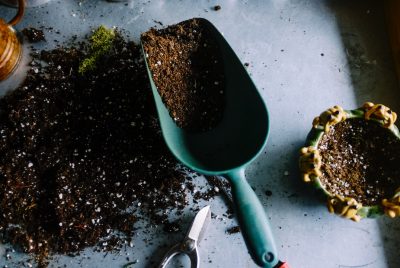Edible Purple Flowers to Spice up your Meals
Hey there! Other than the usual fruits and vegetables to add to your everyday meals, do you know that some flowers are edible and they can add plenty of vibrant color onto your plates. Not only do they lend a burst of color to your plate, but these delicate blooms also bring unique flavors that can turn ordinary meals into extraordinary experiences. In this article, I’ll introduce you to a delightful array of edible purple flowers, share insights on planting them, and provide some mouthwatering suggestions to get you started on your floral culinary journey.
Embracing the World of Edible Purple Flowers
Imagine a symphony of colors and flavors right at your dining table. Edible purple flowers offer a creative way to elevate your culinary creations. These blossoms are not only visually captivating but also pack a punch of unique tastes, from sweet to savory, and even a hint of spiciness, that can transform your dishes into unforgettable feasts.
1. Lavender: Elegance with a Hint of Sweetness
With its enchanting aroma and subtle sweetness, lavender is not just a beautiful garden addition; it’s a versatile herb that can elevate your culinary experiences. Their edible purple flowers, with their soothing aroma, slightly sweet and citrusy flavor, can bring a touch of elegance to your dishes.
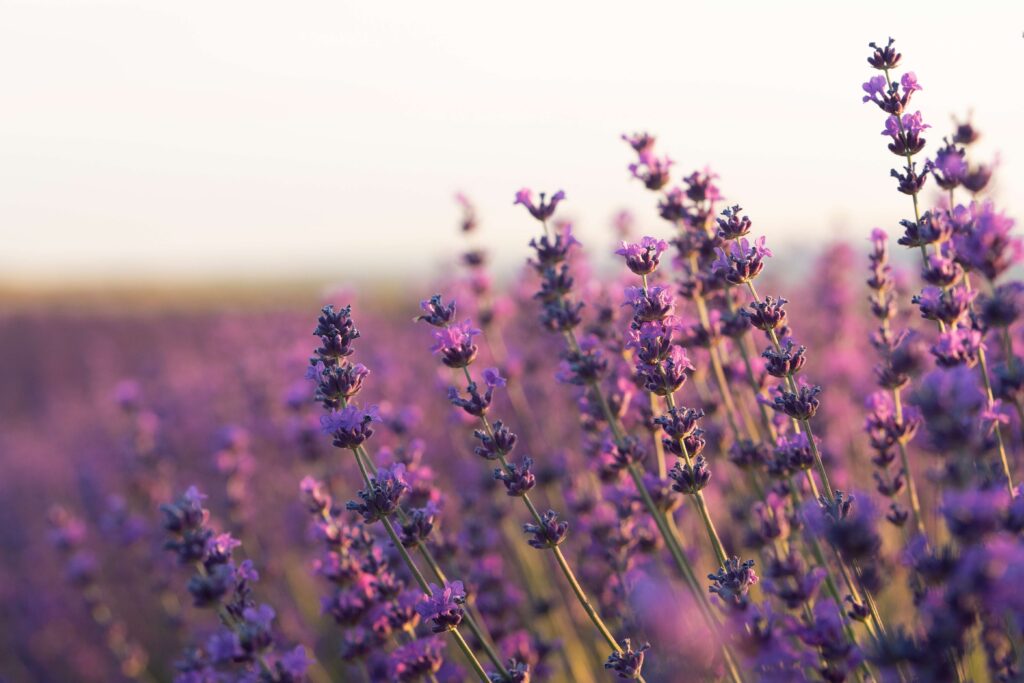
Growing Lavender: A Simple Guide
- Choosing the Right Spot: Lavender loves sunlight, so find a sunny spot in your garden. Ensure the soil is well-draining to prevent waterlogged roots.
- Preparing the Soil: Before planting, mix in some sand or gravel to improve drainage. Lavender prefers slightly alkaline soil.
- Planting Lavender: You can plant lavender from seeds or cuttings. Space the plants about 2 to 3 feet apart to allow proper air circulation.
- Watering: Lavender doesn’t like overly wet feet. Water sparingly but deeply, allowing the soil to dry between waterings.
- Pruning: Trim the plants lightly in the spring to encourage bushier growth. After flowering, prune back the spent blooms to promote new growth.
Using Lavender flowers
- Lavender-Infused Syrups and Sauces: Create a fragrant lavender syrup by simmering lavender blooms with water and sugar. Drizzle it over pancakes, waffles, or use it as a sweetener in beverages and cocktails.
- Lavender-Flavored Baked Goods: Add a twist to your baking by incorporating dried lavender flowers into recipes. Lavender pairs wonderfully with shortbread cookies, scones, and cakes.
Harvesting Lavender Blossoms for Culinary Use
- Timing: Harvest lavender when the flowers are in full bloom. The peak time is usually midsummer when the flowers are vibrant and aromatic.
- Harvesting: Snip the flower stems just above the leaves. Use the flowers fresh or dry them by hanging them upside down in a dark, well-ventilated area.
- Storing: Store dried lavender flowers in airtight containers away from direct sunlight. This way, you can enjoy their flavor and aroma for months.
2. Violets: Delicate Blooms with Subtle Flair
Dainty petals of Violets possess a subtly floral and slightly perfumed taste. They can add a pop of color to your salads, with their delicate flavor pairing wonderfully with fresh greens, cheeses, and vinaigrettes.
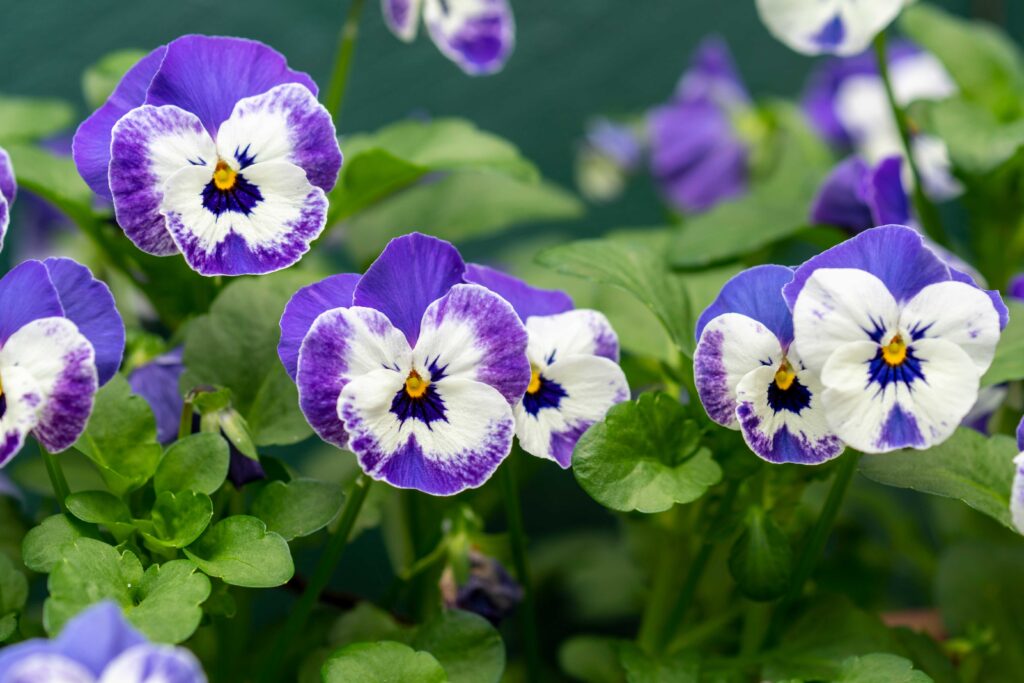
Growing Violets: A Simple Guide
- Ideal Growing Conditions: Violets thrive in partial shade, making them perfect for areas with dappled sunlight. Choose a spot with well-draining soil to prevent waterlogging.
- Planting Violets: You can plant violet seeds or young plants in spring or fall. Space them about 6 to 8 inches apart to give them room to grow.
- Watering: Keep the soil consistently moist, but not soggy. Water the plants at the base to prevent wetting the leaves, which can lead to diseases.
- Mulching: Apply a layer of mulch around the plants to retain moisture and suppress weed growth. Avoid covering the crown of the plants.
- Deadheading: To encourage continuous blooming, remove faded flowers by pinching them off at the base of the stem.
Using Violet flowers
- Violet-Infused Sugar: Create a delicately flavored violet-infused sugar by placing fresh violet petals in a jar with granulated sugar. Let it sit for a week, then use it in baking.
- Violet-Infused Vinegar: Add a unique twist to your salads by infusing vinegar with violet petals. Simply place the petals in a clean glass jar and cover with vinegar. Let it steep for a couple of weeks.
- Candied Violets: Dip violet petals in beaten egg white, then sprinkle them with superfine sugar. Let them dry on parchment paper to create charming edible decorations.
- Violet-Flavored Jams and Jellies: Incorporate violet petals into homemade jams or jellies for a touch of floral sweetness that pairs well with toast and scones.
- Decorative Ice Cubes: Freeze violet petals in ice cubes to add a burst of color and elegance to your beverages.
Harvesting Violets for Culinary Use
- Timing: Harvest violet blossoms when they’re fully open and vibrant in color. Morning is usually the best time for picking.
- Harvesting: Gently pluck the petals from the stem. You can use them immediately or preserve them for later use.
- Storing: If not using immediately, store violet petals in an airtight container in the refrigerator. They can last for a few days this way.
3. Chive Blossoms: A Mild Onion Essence
Chives are most harvested for their vibrant green stalks but chive blossoms also offer a mild onion flavor that’s not overpowering. Use them to garnish salads, soups, or creamy dips for a hint of oniony goodness. Use chive blossoms as a sophisticated garnish for scrambled eggs, pasta dishes, or creamy soups.
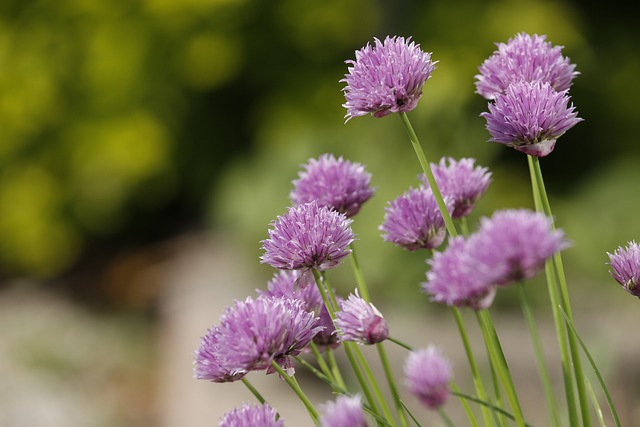
Growing Chive Blossoms: A Simple Guide
- Ideal Growing Conditions: Chive blossoms are an extension of chives, so they thrive in similar conditions. Plant chives in well-draining soil and a sunny spot.
- Planting Chives: Plant chives either from seeds or young plants. Give them enough space to grow—about 6 inches apart—so their blossoms can flourish.
- Watering: Keep the soil consistently moist, but avoid overwatering. Water at the base of the plants to prevent dampening the flowers.
- Encouraging Blossom Growth: To encourage chive blossoms, let a portion of your chive plants mature and avoid harvesting all the leaves. Blossoms will follow.
Using Chive Blossoms
- Vibrant Garnish: Use whole chive blossoms to add a pop of color and delicate onion flavor to salads, soups, omelets, and even cocktails.
- Infused Vinegars: Place chive blossoms in a glass jar and cover them with white wine or champagne vinegar. Let them infuse for a week or so, then strain and use the flavored vinegar in dressings.
- Herb Butter with a Twist: Mix chopped chive blossoms into softened butter for a visually appealing and savory spread for bread or grilled meats.
- Floral Vinaigrette: Blend chive blossoms into your homemade vinaigrette for a subtle onion note that beautifully complements fresh greens.
- Fancy Cream Cheese: Blend chive blossoms into cream cheese or a cream cheese-based spread for bagels, crackers, or finger sandwiches.
Harvesting Chive Blossoms for Culinary Use
- Timing: Harvest chive blossoms when they’re in full bloom but still vibrant and fresh-looking.
- Harvesting: Gently snip the blossoms from the stem using kitchen scissors. Avoid plucking them by hand to prevent damage.
- Storing: Keep the whole dried blossoms in an airtight container, such as a glass jar or airtight plastic container. Store them in a cool, dark place to maintain their flavor and color.
Beyond Purple: Exploring Other Edible Flower Options
- Calendula: Sunshine on Your Plate Calendula petals offer a mild saffron-like flavor and a vibrant golden hue. They’re great for adding color to rice dishes and soups.
- Nasturtiums: Peppery Zing and Vibrancy Nasturtium flowers have a peppery taste that adds a delightful kick to salads and seafood dishes. Both the flowers and leaves are edible.
- Rose Petals: Romance and Delicacy Rose petals bring a touch of romance to your cuisine. They have a subtle floral taste and are perfect for desserts, jams, and infused honey.
- Blue Pea Plant: Great as a refreshing drink, especially with it’s color-changing “show” to wow your guests!
Frequently Asked Questions (FAQs)
- Can all types of flowers be eaten? While many flowers are edible, not all are safe for consumption. Stick to well-known edible varieties to ensure safety.
- What precautions should I take when consuming edible flowers? Only consume flowers that you are certain are safe to eat. If you have allergies, consult a medical professional before trying new blooms.
- Are there any flowers I should avoid using in cooking? Avoid flowers treated with pesticides or herbicides. Also, steer clear of flowers from florists, as they might not be intended for consumption.
- How do I prevent bitterness when using flowers in recipes? Remove the bitter white base of petals before use, as it can affect the taste. Taste a small amount before incorporating into larger dishes.
- Where can I buy edible flowers if I don’t want to grow them myself? Some grocery stores or specialty markets carry edible flowers. Just ensure they are labeled as edible and intended for culinary use.
Conclusion
Embrace the world of edible purple flowers and let their vibrant colors and flavors dazzle your taste buds. Whether you’re a seasoned chef or an adventurous home cook, experimenting with these delicate blooms will undoubtedly enhance your cooking experience and add a burst of flavors into your meals. So, go ahead, sow the seeds of creativity, and let your dishes bloom with elegance and taste!
